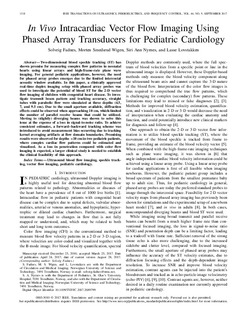| dc.contributor.author | Fadnes, Solveig | |
| dc.contributor.author | Wigen, Morten Smedsrud | |
| dc.contributor.author | Nyrnes, Siri Ann | |
| dc.contributor.author | Løvstakken, Lasse | |
| dc.date.accessioned | 2018-04-11T11:13:37Z | |
| dc.date.available | 2018-04-11T11:13:37Z | |
| dc.date.created | 2017-06-01T14:42:38Z | |
| dc.date.issued | 2017 | |
| dc.identifier.citation | IEEE Transactions on Ultrasonics, Ferroelectrics and Frequency Control. 2017, 64 (9), 1318-1326. | nb_NO |
| dc.identifier.issn | 0885-3010 | |
| dc.identifier.uri | http://hdl.handle.net/11250/2493632 | |
| dc.description.abstract | Two-dimensional blood speckle tracking (ST) has shown promise for measuring complex flow patterns in neonatal hearts using linear arrays and high-frame-rate plane wave imaging. For general pediatric applications, however, the need for phased array probes emerges due to the limited intercostal acoustic window available. In this paper, a clinically approved real-time duplex imaging setup with phased array probes was used to investigate the potential of blood ST for the 2-D vector flow imaging of children with congenital heart disease. To investigate transmit beam pattern and tracking accuracy, straight tubes with parabolic flow were simulated at three depths (4.5, 7, and 9.5 cm). Due to the small aperture available, diffraction effects could be observed when approaching 10 cm, which limited the number of parallel receive beams that could be utilized. Moving to (slightly) diverging beams was shown to solve this issue at the expense of a loss in signal-to-noise ratio. To achieve consistent estimates, a forward-backward tracking scheme was introduced to avoid measurement bias occurring due to tracking kernel averaging artifacts at flow domain boundaries. Promising results were observed for depths <;10 cm in two pediatric patients, where complex cardiac flow patterns could be estimated and visualized. As a loss in penetration compared with color flow imaging is expected, a larger clinical study is needed to establish the clinical feasibility of this approach. | nb_NO |
| dc.language.iso | eng | nb_NO |
| dc.publisher | Institute of Electrical and Electronics Engineers (IEEE) | nb_NO |
| dc.title | In vivo intracardiac vector flow imaging using phased array transducers for pediatric cardiology | nb_NO |
| dc.type | Journal article | nb_NO |
| dc.type | Peer reviewed | nb_NO |
| dc.description.version | publishedVersion | nb_NO |
| dc.source.pagenumber | 1318-1326 | nb_NO |
| dc.source.volume | 64 | nb_NO |
| dc.source.journal | IEEE Transactions on Ultrasonics, Ferroelectrics and Frequency Control | nb_NO |
| dc.source.issue | 9 | nb_NO |
| dc.identifier.doi | 10.1109/TUFFC.2017.2689799 | |
| dc.identifier.cristin | 1473553 | |
| dc.relation.project | Norges forskningsråd: 230455 | nb_NO |
| dc.relation.project | Norges forskningsråd: 237887 | nb_NO |
| dc.description.localcode | © 2017 IEEE. Oepn access. Personal use of this material is permitted. Permission from IEEE must be obtained for all other uses, in any current or future media, including reprinting/republishing this material for advertising or promotional purposes, creating new collective works, for resale or redistribution to servers or lists, or reuse of any copyrighted component of this work in other works. | nb_NO |
| cristin.unitcode | 194,65,25,0 | |
| cristin.unitname | Institutt for sirkulasjon og bildediagnostikk | |
| cristin.ispublished | true | |
| cristin.fulltext | postprint | |
| cristin.qualitycode | 1 | |
